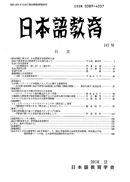
- |<
- <
- 1
- >
- >|
-
The Issue of Inflexibility in Beginner's Level Sentence PatternsNaoko ENDO2008Volume 137 Pages 21-30
Published: 2008
Released on J-STAGE: October 30, 2022
JOURNAL FREE ACCESSIn the course of teaching and learning Japanese as a second language from beginner's level to intermediate, it is often observed that Japanese language students (hereinafter referred to as students), Japanese language teachers (hereinafter referred to as teachers) or both of the above parties are tied to the meanings and rules of use of sentence patterns that they have already learned at the beginner's level and become unable to turn their attention to the diverse meanings and rules of use of such sentence patterns. The author calls this phenomenon "inflexibility in beginner's level sentence patterns"
This study centers its discussion around the issue of students' inflexibility in beginner's level sentence patterns. The discussion is developed around the analysis of a survey conducted in order to examine whether this phenomenon really exists among students. The survey researched the awareness of students and native speakers of the Japanese language (hereinafter referred to as native speakers) with reference to the context in which ...te mo ii desu ne is used by citing conversational situations that include utterances that allow the use of the sentence-ending particle ne in the beginner's sentence pattern ...te mo ii desu.
The results of the survey showed notable differences in responses such as those in the situations including utterances of ...te mo ii desu ne where the majority of students recalled the rules of use as "asking for permission" whereas the majority of native speakers recalled the rules of use as "suggestion". Taking these results into account, the author proposes that beginner's level sentence patterns should be re-introduced at intermediate and advanced levels as a more practical expression integrating sentence-ending particles, etc., and that they should be studied in a developmental manner. Further, through this, the author states that the issue of inflexibility in beginner's level sentence patterns will be solved and that it may be possible to promote the learning of diverse expressions by students.
View full abstractDownload PDF (4095K)
- |<
- <
- 1
- >
- >|